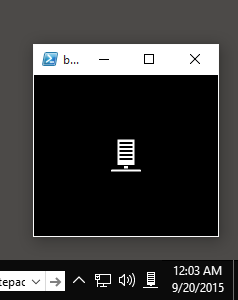Use base64 for NotifyIcon in PowerShell
In addition to be able to use base64 for Images in WPF-based PowerShell Forms, you can also use base64 for icons as well. Essentially, you take the base64, convert it to a memory stream, draw an image from that stream, then convert the image to an icon. Finally, you assign the $notify.Icon this new variable.
Just the NotifyIcon Part
# Add required assembly Add-Type -AssemblyName PresentationFramework, System.Windows.Forms
here's the base64 string
$base64 = "iVBORw0KGgoAAAANSUhEUgAAAEAAAABACAYAAACqaXHeAAAAAXNSR0IArs4c6QAAAARnQU1BAACxjwv8YQUAAAAJcEhZcwAADsMAAA7 DAcdvqGQAAAAYdEVYdFNvZnR3YXJlAHBhaW50Lm5ldCA0LjAuNWWFMmUAAAJESURBVHhe7ZZRaiNRDAR9ON//St4JKIskikc3gwaBU1 A/DQ9V/DHk9fl87rgFapPE0XAL1CaJo+EWqE0SR8MtUJskjoZboDZJHA0L7/f79YRxLtO7ZHE0LFDshHEu07tkcTQsUOyEcS7Tu2RxN CxQ7IRxLtO7ZHE03AK1SeJouAVqk8TRcAvUJomj4RaoTRJHwwJ9sCaMc5neJYujYYFiJ4xzmd4li6NhgWInjHOZ3iWLo2GBYieMc5ne JYuj4RaoTRJHwy1QmySOhlugNkkcDbdAbZI4GhbogzVhnMv0LlkcDQsUO2Gcy/QuWRwNCxQ7YZzL9C5ZHA0LFDthnMv0LlkcDbdAbZI 4Gm6B2iRxNNwCtUniaLgFapPE0bBAH6wJ41ymd8niaFig2AnjXKZ3yeJoWKDYCeNcpnfJ4mhYoNgJ41ymd8niaLgFapPE0XAL1CaJo+ EWqE0SR8MtUJskjoYF+mBNGOcyvUsWR8MCxU4Y5zK9SxZHwwLFThjnMr1LFkfDAsVOGOcyvUsWR8MtUJskjoZboDZJHA23QG2SOBpug dokcTTcArVJ4mi4BWqTxNFwC9QmiaPhFqhNEkfDLVCbJI6GW6A2SRwd6V/VJ6UmRxwdKepJqckRR0eKOnm9OUJvTl5PbomjI0WdvN4c oTcnrye3xNGRok5eb47Qm5PXk1vi6EhRJ683R+jNyevJLXF0pKiT15sj9Obk9eSWODpS1JNSkyOOjhT1pNTk2Idv4f/f/I1//C9/P8C PX/4DfF7/AHQpDe71ItxOAAAAAElFTkSuQmCC"
Create a streaming image by streaming the base64 string to a bitmap streamsource
$bitmap = New-Object System.Windows.Media.Imaging.BitmapImage $bitmap.BeginInit() $bitmap.StreamSource = [System.IO.MemoryStream][System.Convert]::FromBase64String($base64) $bitmap.EndInit() $bitmap.Freeze()
Convert the bitmap into an icon
$image = [System.Drawing.Bitmap][System.Drawing.Image]::FromStream($bitmap.StreamSource) $icon = [System.Drawing.Icon]::FromHandle($image.GetHicon())
Create NotificationIcon and set its default values
$notify = New-Object System.Windows.Forms.NotifyIcon $notify.Text = "Example usage" $notify.Visible = $true
This is where the icon is actually set
$notify.Icon = $icon
Add Event to exit example
$notify.add_Click({ $notify.Visible = $false $notify.Dispose() })
Easy enough, right? So what if you want to use base64 as both an icon and as an image within the form? Check out the code below.
NotifyIcon + base64 WPF Image
Use this (taking note of the comments):
# Add required assembly Add-Type -AssemblyName PresentationFramework, System.Windows.Forms
here's the base64 string
$base64 = "iVBORw0KGgoAAAANSUhEUgAAAEAAAABACAYAAACqaXHeAAAAAXNSR0IArs4c6QAAAARnQU1BAACxjwv8YQUAAAAJcEhZcwAADsMAAA7 DAcdvqGQAAAAYdEVYdFNvZnR3YXJlAHBhaW50Lm5ldCA0LjAuNWWFMmUAAAJESURBVHhe7ZZRaiNRDAR9ON//St4JKIskikc3gwaBU1 A/DQ9V/DHk9fl87rgFapPE0XAL1CaJo+EWqE0SR8MtUJskjoZboDZJHA0L7/f79YRxLtO7ZHE0LFDshHEu07tkcTQsUOyEcS7Tu2RxN CxQ7IRxLtO7ZHE03AK1SeJouAVqk8TRcAvUJomj4RaoTRJHwwJ9sCaMc5neJYujYYFiJ4xzmd4li6NhgWInjHOZ3iWLo2GBYieMc5ne JYuj4RaoTRJHwy1QmySOhlugNkkcDbdAbZI4GhbogzVhnMv0LlkcDQsUO2Gcy/QuWRwNCxQ7YZzL9C5ZHA0LFDthnMv0LlkcDbdAbZI 4Gm6B2iRxNNwCtUniaLgFapPE0bBAH6wJ41ymd8niaFig2AnjXKZ3yeJoWKDYCeNcpnfJ4mhYoNgJ41ymd8niaLgFapPE0XAL1CaJo+ EWqE0SR8MtUJskjoYF+mBNGOcyvUsWR8MCxU4Y5zK9SxZHwwLFThjnMr1LFkfDAsVOGOcyvUsWR8MtUJskjoZboDZJHA23QG2SOBpug dokcTTcArVJ4mi4BWqTxNFwC9QmiaPhFqhNEkfDLVCbJI6GW6A2SRwd6V/VJ6UmRxwdKepJqckRR0eKOnm9OUJvTl5PbomjI0WdvN4c oTcnrye3xNGRok5eb47Qm5PXk1vi6EhRJ683R+jNyevJLXF0pKiT15sj9Obk9eSWODpS1JNSkyOOjhT1pNTk2Idv4f/f/I1//C9/P8C PX/4DfF7/AHQpDe71ItxOAAAAAElFTkSuQmCC"
Create a streaming image by streaming the base64 string to a bitmap streamsource
$bitmap = New-Object System.Windows.Media.Imaging.BitmapImage $bitmap.BeginInit() $bitmap.StreamSource = [System.IO.MemoryStream][System.Convert]::FromBase64String($base64) $bitmap.EndInit() $bitmap.Freeze()
Convert the bitmap into an icon
$image = [System.Drawing.Bitmap][System.Drawing.Image]::FromStream($bitmap.StreamSource) $icon = [System.Drawing.Icon]::FromHandle($image.GetHicon())
Create NotificationIcon and set its default values
$notify = New-Object System.Windows.Forms.NotifyIcon $notify.Text = "Example usage" $notify.Visible = $true
This is where the icon is actually set
$notify.Icon = $icon
Add Event to exit example
$notify.add_Click({ $notify.Visible = $false $notify.Dispose() $form.Close() })
Create the form to display the image
Setup the XAML
[xml]$script:xaml = '
'
Create the form and set variables
$script:form = [Windows.Markup.XamlReader]::Load((New-Object System.Xml.XmlNodeReader $xaml)) $xaml.SelectNodes("//*[@Name]") | ForEach-Object { Set-Variable -Name ($_.Name) -Value $form.FindName($_.Name) -Scope Script }
Set source here. Take note in the XAML as to where the variable name was taken.
$thisistheimage.source = $bitmap
Clean up once closed
$form.Add_Closed({ $notify.Visible = $false $notify.Dispose() })
Show form
$form.ShowDialog() | Out-Null
PowerShell + WPF = <3
